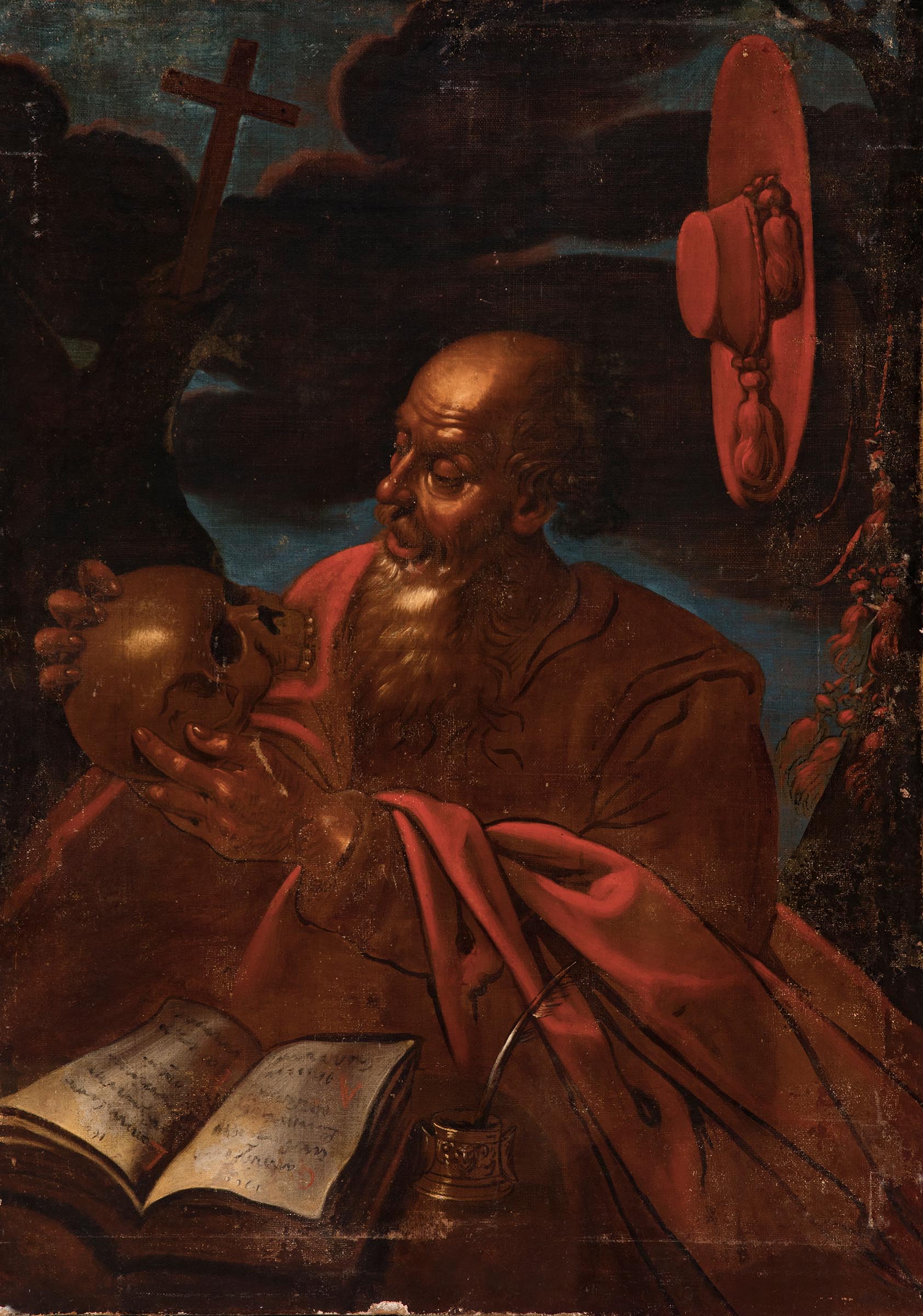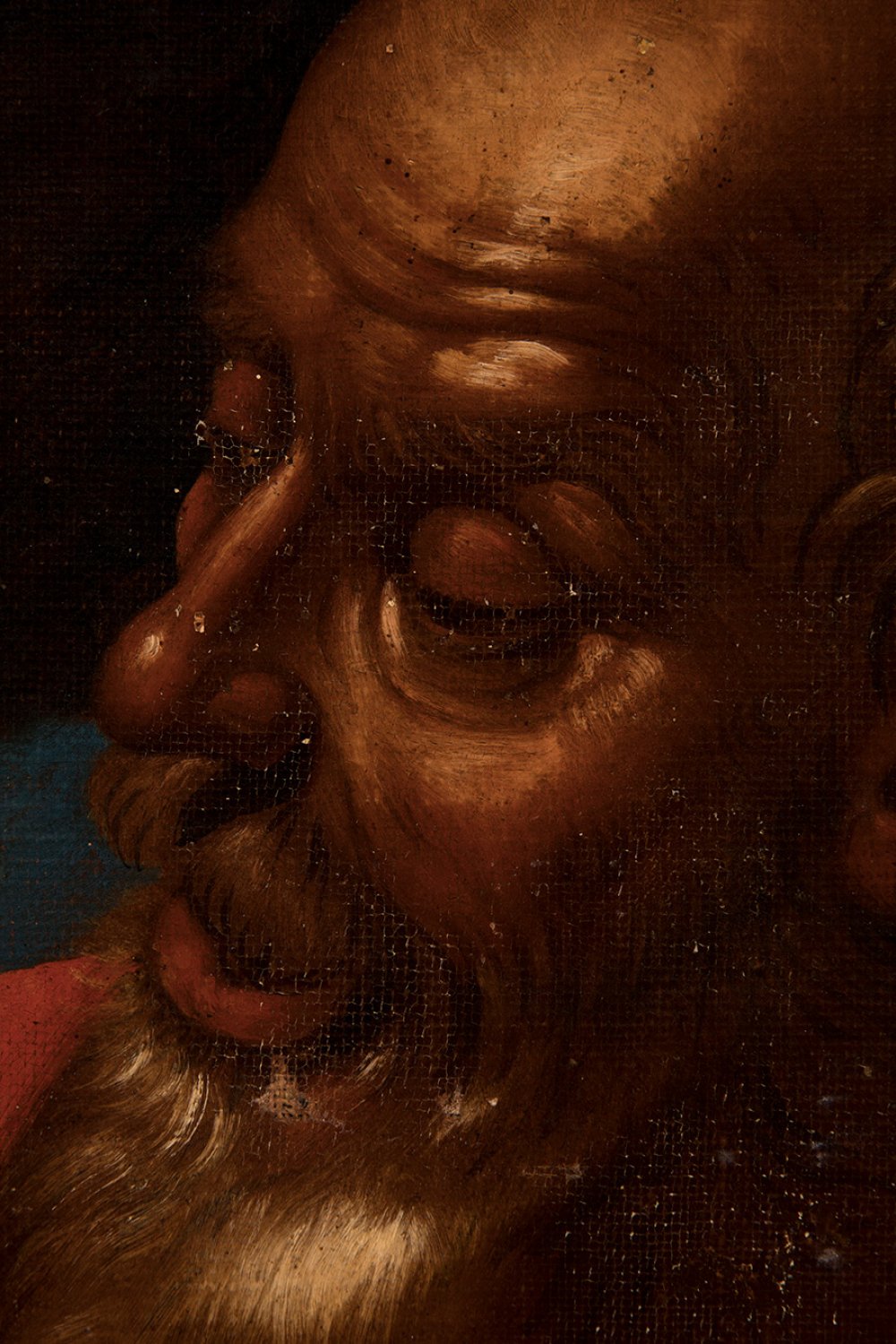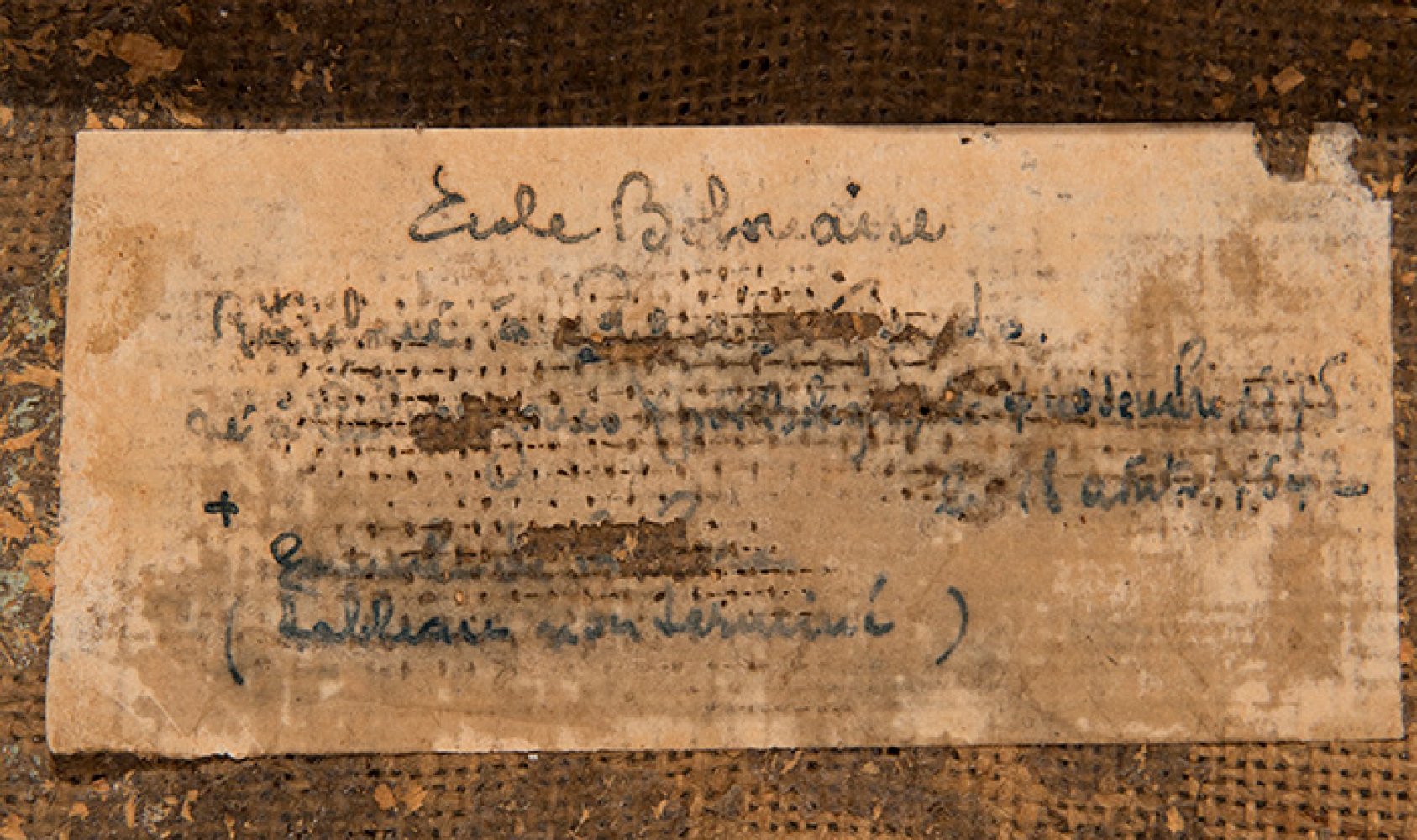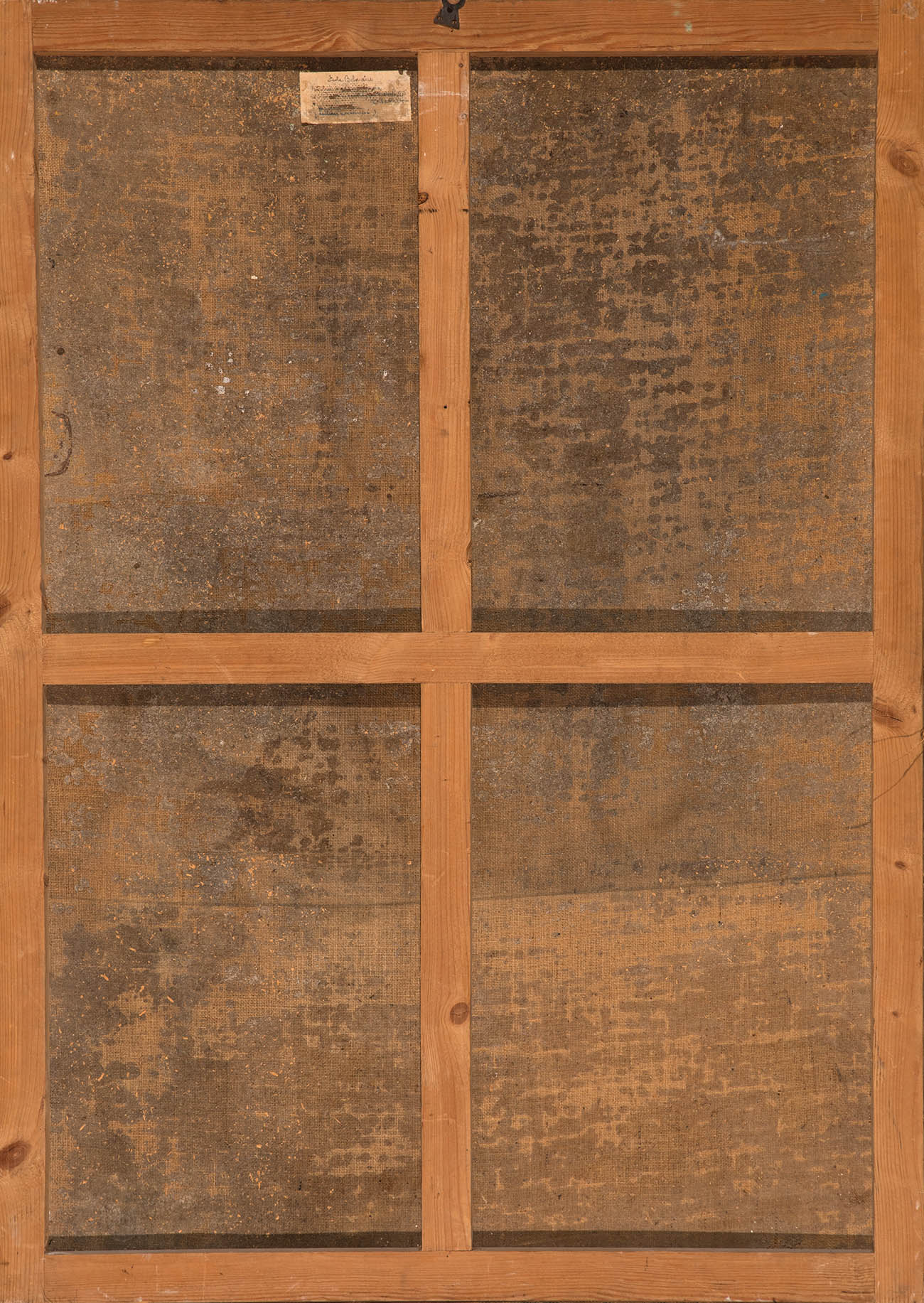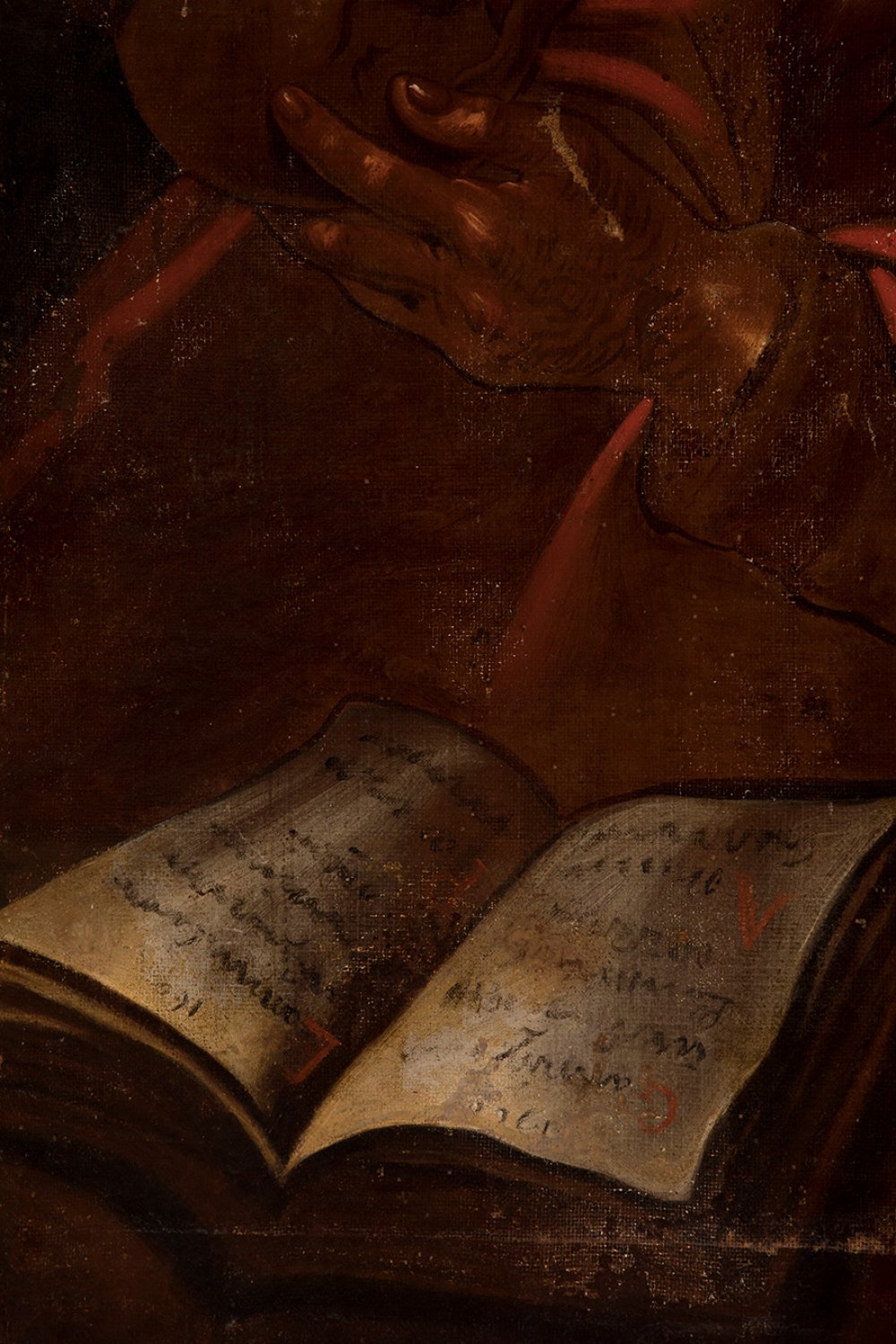14
Italian school, first half of the 17th century."Penitent Saint Jerome".Oil on canvas. Re-drawn.Leaps
"Penitent Saint Jerome".
Oil on canvas. Re-drawn.
Leaps and restorations.
Measurements: 132 x 95 cm.
In this painting ascribed to the Italian Baroque, St. Jerome is represented in the foreground taking a skull in his hands and opening in front of him, in a random page, a volume of the Gospels. Both attributes are symbolically interpreted as a reflection on the vanity of earthly goods and the fleeting nature of existence (the Vanitas theme), as well as the saint's role as the first translator of the Bible. The wiry features of the face are chiselled with expressive chiaroscuro. The intense contrasts of light, rooted in the Caravaggist tradition, lend a supernatural quality to the landscape of cobalt shades in which the saint is depicted. The long beard sparkles in subtle golden locks, and the bronze tone is prolonged in the vivid flesh tones. The half-open lips and the folds of the forehead concentrate a highly emotive image, characteristic of 17th-century devotional paintings.
One of the four great Doctors of the Latin Church, Saint Jerome was born near Aquileia (Italy) in 347. Trained in Rome, he was an accomplished rhetorician and polyglot. Baptised at the age of nineteen, between 375 and 378 he withdrew to the Syrian desert to lead an anchorite's life. He returned to Rome in 382 and became a collaborator of Pope Damasus. One of the most frequent representations of this saint is his penance in the desert. His attributes are the stone he uses to beat his chest and the skull on which he meditates. Also the cardinal's cape (or a red mantle), although he was never a cardinal, and the tamed lion. The latter comes from a story in the "Golden Legend", where it is narrated that one day, when he was explaining the Bible to the monks in his convent, he saw a lion limping towards him. He removed the thorn from its paw, and from then on kept it in his service, instructing it to look after his donkey while it grazed. Some merchants stole the donkey, and the lion recovered it, returning it to the saint without hurting the animal.
"Penitent Saint Jerome".
Oil on canvas. Re-drawn.
Leaps and restorations.
Measurements: 132 x 95 cm.
In this painting ascribed to the Italian Baroque, St. Jerome is represented in the foreground taking a skull in his hands and opening in front of him, in a random page, a volume of the Gospels. Both attributes are symbolically interpreted as a reflection on the vanity of earthly goods and the fleeting nature of existence (the Vanitas theme), as well as the saint's role as the first translator of the Bible. The wiry features of the face are chiselled with expressive chiaroscuro. The intense contrasts of light, rooted in the Caravaggist tradition, lend a supernatural quality to the landscape of cobalt shades in which the saint is depicted. The long beard sparkles in subtle golden locks, and the bronze tone is prolonged in the vivid flesh tones. The half-open lips and the folds of the forehead concentrate a highly emotive image, characteristic of 17th-century devotional paintings.
One of the four great Doctors of the Latin Church, Saint Jerome was born near Aquileia (Italy) in 347. Trained in Rome, he was an accomplished rhetorician and polyglot. Baptised at the age of nineteen, between 375 and 378 he withdrew to the Syrian desert to lead an anchorite's life. He returned to Rome in 382 and became a collaborator of Pope Damasus. One of the most frequent representations of this saint is his penance in the desert. His attributes are the stone he uses to beat his chest and the skull on which he meditates. Also the cardinal's cape (or a red mantle), although he was never a cardinal, and the tamed lion. The latter comes from a story in the "Golden Legend", where it is narrated that one day, when he was explaining the Bible to the monks in his convent, he saw a lion limping towards him. He removed the thorn from its paw, and from then on kept it in his service, instructing it to look after his donkey while it grazed. Some merchants stole the donkey, and the lion recovered it, returning it to the saint without hurting the animal.
28th September - Old Masters
Sale Date(s)
Venue Address
General delivery information available from the auctioneer
Setdart offers Worldwide shipping
PICK UP IN ROOM: You can come and pick up your lots in our offices (Barcelona, Madrid or Valencia). At the moment of the withdrawal, you will be able to accept the current conditions of the lot by means of a document that you will sign.
YOU CAN SEND ANOTHER PERSON TO PICK UP: This person must present a signed authorization that you can find in our web page by accessing from BUY AT SETDART- LOGISTICS-DOWNLOAD AUTHORIZATION DOCUMENT. You can also send an e-mail with the requested data in AUTHORIZATION DOCUMENT to admin@setdart.com
Important Information
25% buyer´s premium
21% buyer´s premium at www.setdart.com
Terms & Conditions
The maximum period to pay the lots is 7 working days. You can pay either via bank transfer or with credit card through our platform www.setdart.com (we only accept VISA or Mastercard).
BUYER´S PREMIUM: 22% Hammer price + 21% VAT from the buyer´s premium
If your piece has more than 100 years, our Ministry of Culture requires an export certificate in order for the piece to leave the country. Note that if the piece goes inside the EU, there is no cost for the export certificate. If the piece goes outside the EU, there is a cost for the export certificate. You can find more information in our Ministry of Culture website: https://www.culturaydeporte.gob.es/en/cultura/patrimonio/exportacionimportacion/exportacion/tasas.html
INQUIRIES: admin@setdart.com
Setdart guides you through the entire process, from the time of award to the day you receive your lot. Our logistics team will be happy to manage your transport, and will advise you on the best shipping method with professionals from the sector used to handling works of art and jewelry.
WE OFFER WORLDWIDE DOOR TO DOOR SHIPPING
PICK UP IN ROOM: You can come and pick up your lots in our offices. At the moment of the withdrawal, you will be able to accept the current conditions of the lot by means of a document that you will sign.
YOU CAN SEND ANOTHER PERSON TO PICK UP: This person must present a signed authorization that you can find in our web page by accessing from BUY AT SETDART-LOGISTICS-DOWNLOAD AUTHORIZATION DOCUMENT. You can also send an e-mail with the requested data in AUTHORIZATION DOCUMENT to admin@setdart.com
SETDART IS NOT RESPONSIBLE FOR THE STATE OF THE PARTS ONCE THEY LEAVE OUR FACILITIES. MRW SHIPMENTS: Once the payment is made, your lot will be packed for shipment, the logistics department will send you an e-mail notifying you of the day it leaves our warehouse, changes of address cannot be made after receiving this e-mail.
INSURANCE INCIDENTS: Coverage for the value of the auction up to 3000 ? per shipment, if the value of the auction is higher, Setdart will send you a quote including the additional insurance. The insurance company WILL NOT BE RESPONSIBLE FOR THE SHIPMENT THAT EXCEEDS THAT AMOUNT AND IS NOT FULLY INSURED. MRW INCIDENTS: Maximum notification 48 hours after receipt, after which the insurance company WILL NOT BE RESPONSIBLE AND NO CLAIMS WILL BE ACCEPTED.
E-MAIL LOGISTICS: logistica@setdart.com
PICK UP YOUR MESSAGES: You can send your own messaging, prior notice via e-mail that your shipment is ready, please note 3 or 4 days in advance. This type of shipment is packaged so Setdart will provide you with a quote.
EXPENSES FOR STORAGE: We inform you that if the purchased lot is not picked up within a month, you will be charged 30€ per week per lot. Setdart Online S.L., owner of the web site "setdart.com", "setdart.net" and "setdart.org", acts as a company of Spanish nationality inscribed in the Volume 36955, sheet 182, page B-293056 of the Mercantile Registry, with registered office at Calle Aragó













